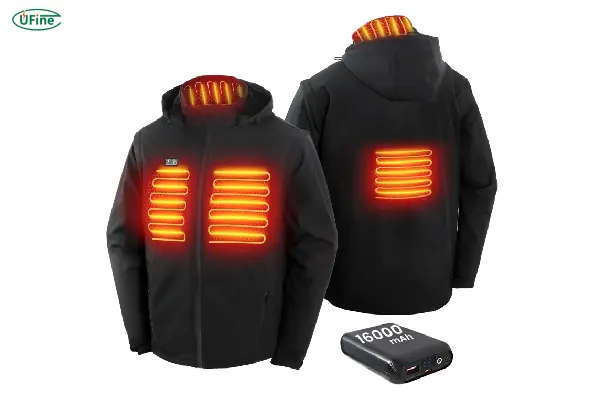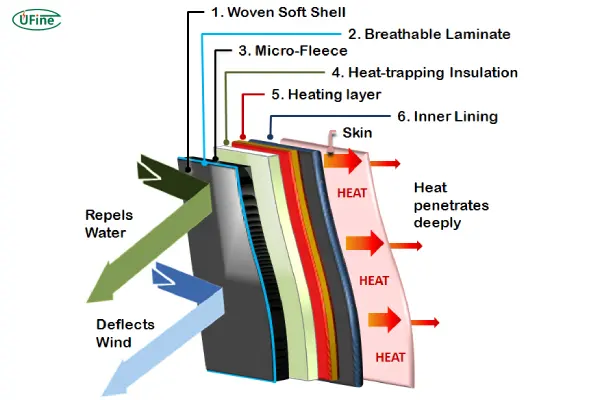
- Part 1. How does a heated jacket battery work?
- Part 2. Types of heated jacket batteries
- Part 3. What is the voltage of a heated jacket battery?
- Part 4. Key features to look for in a heated jacket battery
- Part 5. How long does a heated jacket battery last?
- Part 6. How to charge a heated jacket battery
- Part 7. Safety concerns & best practices
- Part 8. Replacing a heated jacket battery
- Part 9. Final thoughts
- Part 10. FAQs
When winter hits hard, a heated jacket becomes more than just clothing—it becomes a personal heating system. Whether you’re hiking, working outdoors, skiing, or commuting on frosty mornings, heated jackets can be a game-changer. At the core of this tech-enhanced warmth is one essential component: the heated jacket battery.
In this comprehensive guide, we’ll explore in detail how these batteries function, what types are available, their ideal voltage levels, and more. From choosing the best battery to extending its life, this article has you covered.
Part 1. How does a heated jacket battery work?
To understand how a heated jacket battery works, you first need to know what it’s powering. Heated jackets have integrated heating elements—usually carbon fiber or steel wires—placed in strategic locations like the chest, back, and sometimes sleeves or neck. When activated, the battery sends electric current to these elements, which then produce infrared heat.
A heated jacket battery powers heating elements (usually carbon fiber or metal wires) sewn into the jacket. When turned on, electricity flows through these elements, generating heat.
Key Components:
-
Battery Pack – Stores and supplies power.
-
Wiring & Heating Elements – Distribute warmth.
-
Control Unit – Adjusts temperature settings.
How It Works:
-
You charge the battery fully.
-
Connect it to the jacket’s power port.
-
Turn on the heat settings (low, medium, high).
-
The battery sends power to the heating zones (chest, back, sleeves).
You typically activate the heating system with a button on the jacket. The power level can be adjusted—usually with low, medium, and high settings. These settings directly affect how much current is drawn from the battery.
In essence, the battery is the lifeline of your heated jacket, controlling when and how much warmth you feel.
Part 2. Types of heated jacket batteries
Heated jacket batteries come in several varieties. Choosing the right one can significantly affect your experience, from warmth duration to comfort and mobility.
a. Lithium-Ion (Li-ion)
-
The most commonly used battery type in heated apparel.
-
High energy density and rechargeable.
-
Long-lasting and relatively lightweight.
b. Lithium-Polymer (LiPo)
-
Similar to Li-ion but thinner and more flexible.
-
Ideal for tighter spaces and sleeker jacket designs.
-
Slightly more sensitive to physical damage.
c. Nickel-Metal Hydride (NiMH)
-
Older battery tech.
-
Less efficient and heavier.
-
Rarely used in modern heated jackets.
Among these, Li-ion and LiPo batteries dominate the market due to their excellent balance of power, weight, and rechargeability.
For specialized or advanced applications, custom battery solutions may be necessary. Ufine Battery, a leading Chinese lithium battery manufacturer, provides a wide array of options tailored to heated wearables. Our lineup includes lithium polymer, LiFePO4, 18650, and cylindrical batteries. We also supply ultra-thin, high-rate, and high or low-temperature batteries—customizable to suit specific voltage, capacity, and form factor requirements.
For custom heated jacket battery solutions, contact Ufine Battery.
Part 3. What is the voltage of a heated jacket battery?
Voltage determines the power level your battery delivers. The higher the voltage, the faster and hotter the jacket can heat up. Here are the most commonly used voltage levels:
-
5V: USB-powered, very portable but provides minimal heat. Good for mild climates.
-
7.4V: The most common voltage for balanced performance.
-
12V: Offers intense heat, ideal for extremely cold environments, but may require bulkier insulation.
-
15V and above: Used in professional-grade or industrial heated clothing.
It’s critical to match the voltage of the battery to your jacket’s specifications. Mismatched voltage can lead to weak heating or even damage the jacket’s circuitry.
Part 4. Key features to look for in a heated jacket battery

Not all batteries are created equal. When choosing a battery for your heated jacket, prioritize the following features:
Battery Capacity
Measured in milliamp-hours (mAh) or watt-hours (Wh), higher capacity means longer heating time. Typical ranges are 5,000 mAh to 20,000 mAh.
Voltage Compatibility
Always ensure the voltage matches your jacket’s requirements.
Weight and Size
Too large, and it becomes uncomfortable. Too small, and it won’t last. Find a balance.
Charging Interface
USB-C is fast becoming the standard for speed and convenience.
Safety Mechanisms
Overheat protection, over-discharge protection, short-circuit safety, and waterproofing are essential.
A reliable, efficient battery should provide not just power but also safety and comfort in every use.
Part 5. How long does a heated jacket battery last?
It depends on:
-
Battery capacity (e.g., 4000mAh vs. 6000mAh).
-
Heat setting (low lasts longer than high).
-
Outdoor temperature (colder weather drains battery faster).
Average Runtime Estimates
| Battery Capacity | Low Heat | Medium Heat | High Heat |
|---|---|---|---|
| 3000mAh | 8-10 hrs | 5-7 hrs | 3-5 hrs |
| 5000mAh | 12-15 hrs | 8-10 hrs | 5-7 hrs |
Extend Battery Life:
-
Use lower heat settings when possible.
-
Preheat before going outside (saves battery).
-
Keep it warm (cold temps reduce efficiency).
Factors like external temperature, heat setting, and battery age will affect these numbers. Always carry a spare battery for longer adventures or especially cold conditions.
Part 6. How to charge a heated jacket battery
Charging your battery properly ensures both performance and safety.
Basic Charging Instructions:
-
Use the charger that came with the battery.
-
Plug into a wall socket or USB power source.
-
Charging typically takes 3 to 6 hours.
-
Avoid charging in extreme temperatures.
Advanced Charging Tips:
-
Don’t wait until the battery is completely empty before recharging.
-
Unplug the battery once fully charged to prevent overheating.
-
If storing long-term, keep it at around 50% charge and in a cool place.
A smart charger with auto shut-off and battery health monitoring is a worthwhile investment.
Part 7. Safety concerns & best practices
Although heated jacket batteries are generally safe, improper usage can pose risks.
Key Safety Tips:
-
Never use a damaged battery.
-
Avoid exposure to water unless it’s specifically waterproof.
-
Remove the battery before washing your jacket.
-
Keep the battery away from sharp objects or pressure points.
-
Never leave a charging battery unattended.
Also, only use certified batteries from reputable suppliers. Ufine Battery designs our lithium battery packs with built-in safety features such as over-current protection, thermal regulation, and short-circuit prevention. Our batteries are engineered to meet international safety standards, making them ideal for wearable applications.
Looking for safe, high-performance batteries for heated jackets? Contact Ufine Battery today.
Part 8. Replacing a heated jacket battery
Over time, even the best batteries need replacing. Here’s how to do it the right way:
Step-by-Step Replacement Guide:
-
Identify your jacket model and its voltage requirement.
-
Check the connector type (DC port, USB, etc.).
-
Match the size and shape to the original battery.
-
Upgrade wisely—higher capacity is fine, but voltage must match.
-
Buy from a trusted brand to ensure compatibility and safety.
Replacement is also a good opportunity to upgrade to a newer, more efficient battery. Consider faster-charging or higher-capacity models for better performance.
Part 9. Final thoughts
Your heated jacket is only as good as the battery powering it. With the right battery, you get consistent heat, long-lasting performance, and the freedom to stay outdoors longer—even in the coldest weather. Understanding voltage, capacity, battery chemistry, and safety tips will help you choose wisely.
If you’re designing, manufacturing, or sourcing heated jacket batteries, partner with a supplier who understands wearable power needs. Ufine Battery is a leading Chinese custom lithium battery manufacturer that offers:
-
Lithium polymer and LiFePO4 batteries
-
18650 and cylindrical cells
-
Ultra-thin, high-rate, and temperature-resistant models
-
Custom sizes, voltages, capacities, and discharge rates for every application
Contact Ufine Battery today for reliable, custom-engineered power solutions tailored to your heated apparel. Stay warm, stay safe, stay powered.
Part 10. FAQs
Can I use a regular power bank with my heated jacket?
Only if your jacket is designed for 5V USB input. Check the manual.
Is it safe to wear a heated jacket in the rain?
Most are water-resistant. But always remove the battery before washing or if it gets soaked.
Why is my heated jacket not staying warm?
Possible reasons include low battery, damaged wiring, or incompatible battery voltage.
Can I fly with heated jacket batteries?
Yes, but they must be carried in your cabin luggage. Batteries over 100Wh may need airline approval.
What’s the difference between lithium-ion and lithium-polymer batteries?
Li-ion offers higher energy density, while LiPo is thinner and more flexible but slightly less durable.
Related Tags:
More Articles

Battery Rust vs Corrosion: Key Differences and How to Deal With Each
Learn the key differences between battery rust and corrosion, their causes, and how to fix each. Discover why lithium batteries are built to resist both issues.
Why Lithium Batteries Don’t Rust: Chemical Stability Explained
Learn why lithium batteries don’t rust. Their iron-free chemistry and moisture protection make them more corrosion-resistant than lead-acid or alkaline types.
Server Rack Battery vs UPS Battery: What’s the Difference
Discover the difference between server rack and UPS batteries. Compare design, chemistry, performance, and maintenance to select the best data center backup.
How to Choose the Right Server Rack Battery for Your Data Center?
Find out how to choose the right server rack battery for your data center. Consider capacity, runtime, safety, and compatibility for reliable backup power.
What Is a Server Rack Battery? A Complete Guide for Data Centers and IT
Discover what a server rack battery is, how it works, and why it’s essential for reliable data center and IT power backup. Learn key features and benefits.




